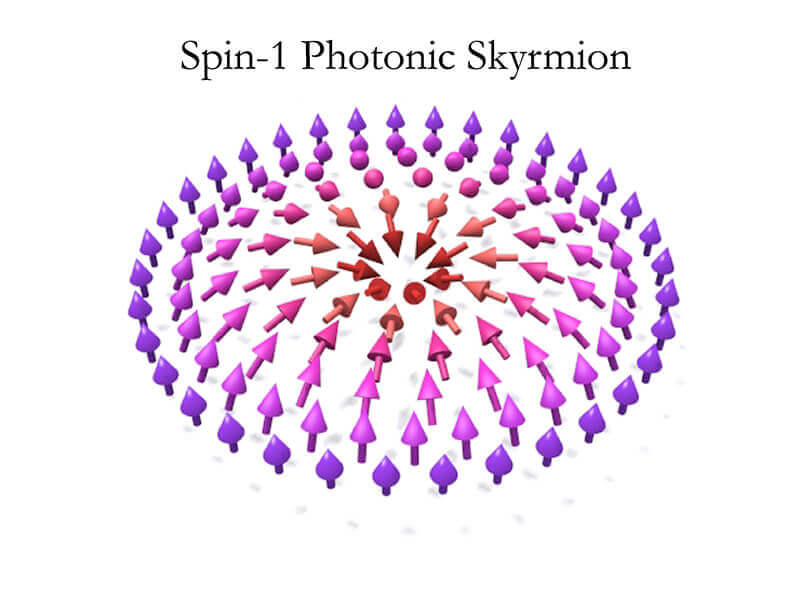August 14, 2019
Researchers propose new topological phase of atomic matter hosting ‘photonic skyrmions’
 Depiction of spin-1 photonic skyrmion. Arrows are related to photon spin in energy-momentum space. (Purdue University image/ Todd van Mechelen)
Download image
Depiction of spin-1 photonic skyrmion. Arrows are related to photon spin in energy-momentum space. (Purdue University image/ Todd van Mechelen)
Download image
WEST LAFAYETTE, Ind. – The field of topology or the study of how surfaces behave in different dimensions has profoundly influenced the current understanding of matter. The prime example is the topological insulator, which conducts electricity only on the surface while being completely insulating inside the bulk. Topological insulators behave like a metal, i.e., silver on the surface, but inside, it would behave like glass. These properties are defined using the conductivity or flow of electrons depicting whether there is a highway or a road-block for their motion. One major driver of future applications for topological insulators is in the field of spin-electronic devices since these electrons spin in unison, all aligned with each other while flowing on the surface.
Now electrical and computer engineering researchers have proposed for the first time that this same electronic conductivity influences the topological properties of light inside atomic matter.
“We showed there can exist a new topological phase of matter where light flows only on the edge of the atomic material but not inside it. There might exist some very special materials with this unique photonic property, and that's what we refer to as the quantum gyroelectric phase of matter,” said Zubin Jacob, an associate professor of electrical and computer engineering at Purdue University.
Another key defining property of this phase of matter is a topological excitation known as the “photonic skyrmion.” In conventional magnets, electron spins can be thought of as tiny arrows that either align or anti-align with each other. In stark contrast, skyrmions are spin excitations that show unique tumbling behavior of the spins (see image). They are extremely stable to stimuli and can be exploited for spintronic switches and memories. The quantum gyroelectric phase hosts skyrmions in energy-momentum space of photonic waves and can be used as a smoking gun signature of this phase of matter.
Such a material might be synthesized by “doping,” or altering the atomic structure, of existing materials. A good place to search for this phase is in two-dimensional materials such as graphene.
Jacob and doctoral student Todd Van Mechelen have authored a series of four papers published in research journals that puts forth the theory of this phase of matter.
The research was funded by the Defense Advanced Research Projects Agency’s Nascent Light-Matter Interactions Program and the National Science Foundation.
Future research will explore doping 2D materials to achieve the quantum gyroelectric phase and investigate how light waves travel on the edge of a material.
Writer: Emil Venere
Source: Zubin Jacob, 765-494-3514, zjacob@purdue.edu
ABSTRACT
Photonic Dirac monopoles and skyrmions: spin-1 quantization [Invited]
Todd Van Mechelen and Zubin Jacob*
1 Birck Nanotechnology Center and Purdue Quantum Center, School of Electrical and Computer Engineering,PurdueUniversity,WestLafayette,Indiana47907,USA *zjacob@purdue.edu
We introduce the concept of a photonic Dirac monopole, appropriate for photonic crystals, metamaterials and 2D materials, by utilizing the Dirac-Maxwell correspondence. We start by exploring the vacuum where the reciprocal momentum space of both Maxwell’s equations and the massless Dirac equation (Weyl equation) possess a magnetic monopole. The critical distinction is the nature of magnetic monopole charges, which are integer valued for photons but half-integer for electrons. This inherent difference is directly tied to the spin and ultimately connects to the bosonic or fermionic behavior. We also show the presence of photonic Dirac strings, which are line singularities in the underlying Berry gauge potential. While the results in vacuum are intuitively expected, our central result is the application of this topological Dirac-Maxwell correspondence to 2D photonic(bosonic) materials, as opposed to conventional electronic(fermionic)materials. Intriguingly, within dispersive matter, the presence of photonic Dirac monopoles is captured by nonlocal quantum Hall conductivity–i.e., a spatiotemporally dispersive gyroelectric constant. For both 2D photonic and electronic media, the nontrivial topologicalphasesemergeinthecontextofmassiveparticleswithbrokentime-reversalsymmetry. However, the bulk dynamics of these bosonic and fermionic Chern insulators are characterized by spin-1 and spin-1⁄2 skyrmions in momentum space, which have fundamentally different interpretations. This is exemplified by their contrasting spin-1and spin-1⁄2 helically quantized edge states. Our work sheds light on the recently proposed quantum gyroelectric phase of matter and the essential role of photon spin quantization in topological bosonic phases.

